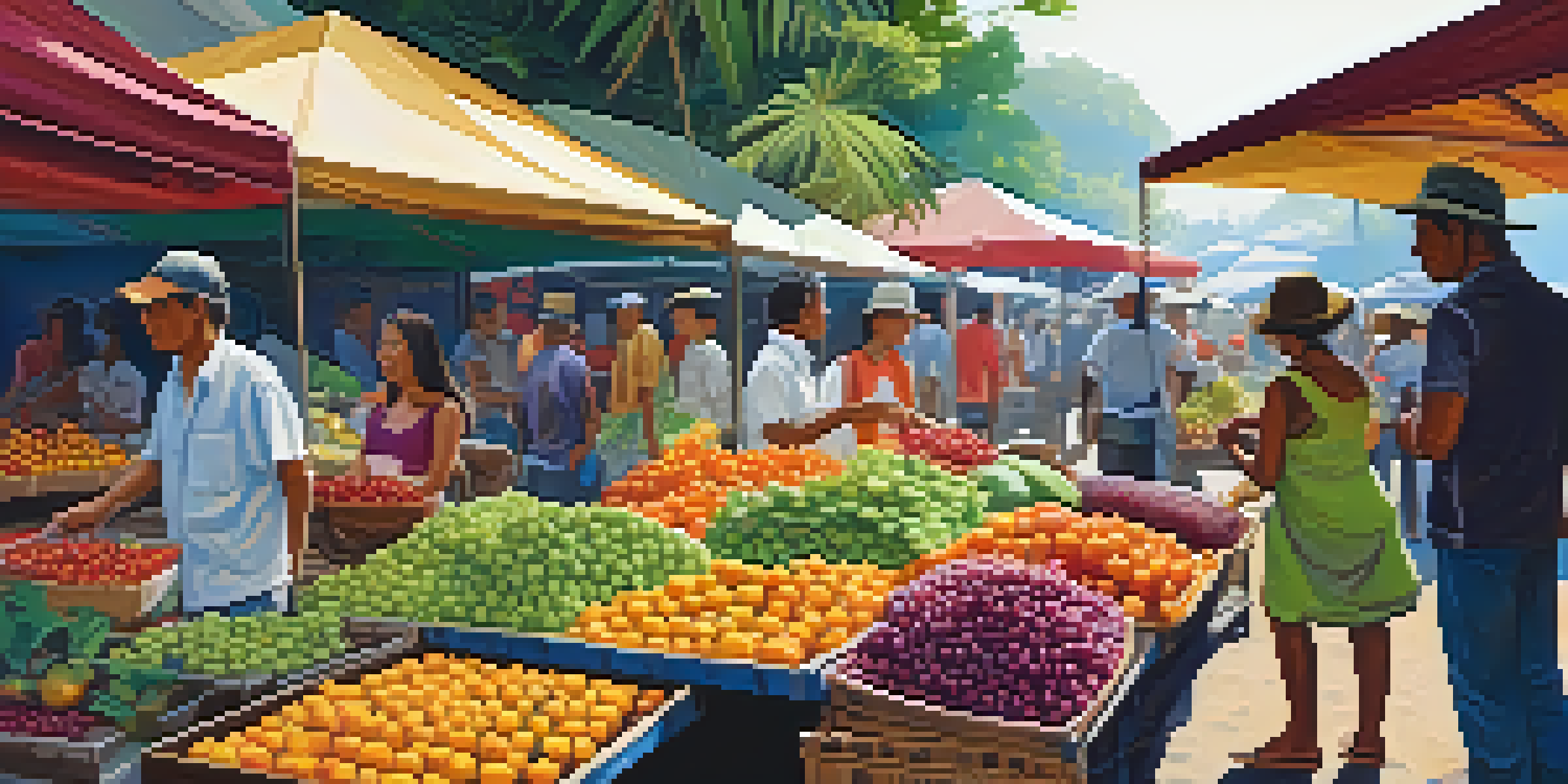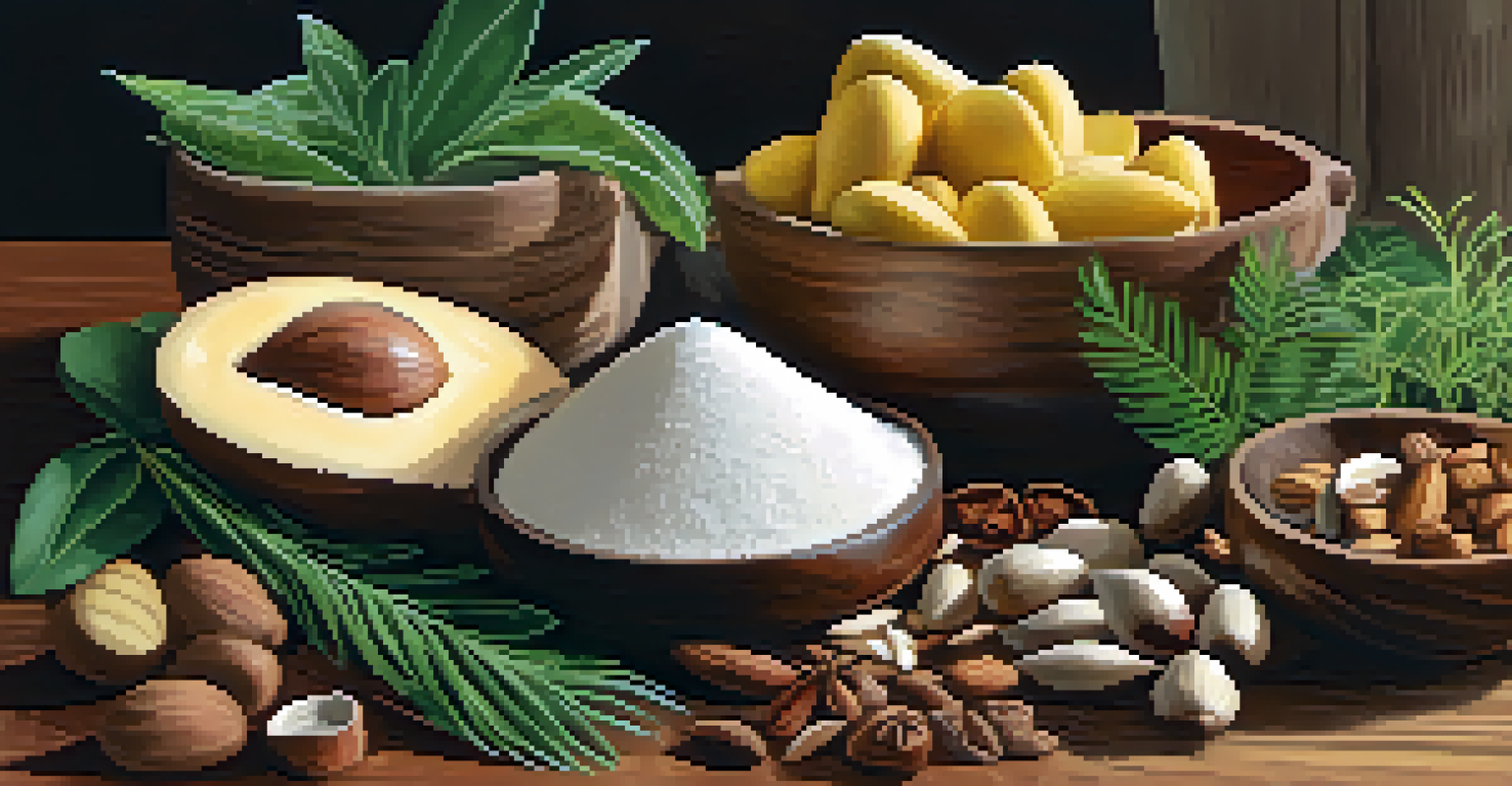From Amazon to Table: Unique Ingredients in Brazilian Cooking

The Amazon's Bounty: A Treasure Trove of Ingredients
Brazil's Amazon rainforest is a culinary goldmine, brimming with unique ingredients that are often overlooked. From exotic fruits like açaí and cupuaçu to lesser-known herbs such as tucupi and jambu, the Amazon provides a vibrant palette for Brazilian cooks. These ingredients not only add flavor but also infuse dishes with a sense of place, connecting people to the rich biodiversity of the region.
Food is not just what we eat; it's a reflection of who we are and where we come from.
Take açaí, for example. This deep purple berry is celebrated not just for its taste but also for its health benefits, making it a popular addition to smoothies and bowls. Similarly, cupuaçu, with its creamy texture and chocolate-like flavor, has become a favorite in desserts, showcasing how Amazonian fruits can elevate traditional recipes.
By incorporating these unique ingredients into their menus, Brazilian chefs are not only preserving cultural heritage but also promoting sustainability and biodiversity. The use of Amazonian ingredients is a testament to the deep-rooted connection between food and the environment in Brazil.
The Role of Indigenous Ingredients in Brazilian Cuisine
Indigenous communities in Brazil have long relied on local ingredients, and their influence can be seen in many traditional dishes. Ingredients like manioc (cassava) and various native fish play a crucial role in the everyday diet of these communities. These staples showcase the resourcefulness and creativity of Indigenous peoples in utilizing what the land offers.

For instance, manioc is not only used in its whole form, but it is also processed into flour for making farofa, a beloved side dish. This versatility demonstrates how a single ingredient can transform into various dishes, highlighting the ingenuity of Brazilian cooking.
Amazon's Unique Ingredients Shine
Brazil's Amazon rainforest offers a wealth of unique ingredients that enhance traditional dishes and promote sustainability.
Moreover, the incorporation of Indigenous ingredients into mainstream Brazilian cuisine fosters a greater appreciation for cultural diversity. It encourages a narrative that honors the original inhabitants of the land and their contributions to the culinary landscape.
Exploring Unique Amazonian Fruits: Beyond the Ordinary
Brazilian cuisine is renowned for its diverse use of fruits, many of which hail from the Amazon. Fruits like bacaba and buriti are not just delicious; they're also packed with nutrients. Bacaba, a dark fruit resembling a small berry, is often used to make a traditional fermented drink, showcasing the creative ways Brazilians utilize their natural resources.
Sustainability is about the future. It's about taking care of the planet so that future generations can enjoy it as we have.
Buriti, on the other hand, is known for its high vitamin A content and is often used in smoothies and desserts. Its rich orange color adds vibrancy to dishes, making it a favorite among chefs looking to add both flavor and nutrition.
These Amazonian fruits are a reminder of nature's bounty and inspire chefs to innovate while remaining grounded in their cultural roots. By bringing these ingredients to the forefront, Brazilian cooking continues to evolve while honoring its rich heritage.
Diving into Brazilian Spices and Seasonings
When it comes to Brazilian cooking, the spices and seasonings used can make all the difference. Common spices like cumin, coriander, and chili pepper are often blended with unique local flavors such as pimenta malagueta and coentro. These ingredients add depth and heat to dishes, creating a symphony of flavors that characterize Brazilian cuisine.
For example, pimenta malagueta is a fiery chili that brings a kick to traditional dishes like moqueca, a fragrant fish stew. Its bold flavor is a staple in many households, proving that the right spice can elevate a meal from ordinary to extraordinary.
Indigenous Influence on Cuisine
The use of Indigenous ingredients like manioc in Brazilian cooking highlights cultural diversity and showcases resourcefulness.
Additionally, the use of fresh herbs like coentro (cilantro) not only enhances flavor but also adds a refreshing element to dishes. This balance of spices and herbs is what makes Brazilian cuisine so vibrant and appealing to the palate.
The Influence of African Ingredients on Brazilian Cooking
Brazil's culinary landscape is significantly shaped by its African heritage, with many ingredients reflecting this rich history. Staples like okra and palm oil are commonly used in Brazilian dishes, particularly in the northeastern region where African influences are most prominent. This blending of cultures has resulted in a unique fusion that defines Brazilian cooking.
Take the dish vatapá, for example. Made with ingredients like ground peanuts, coconut milk, and shrimp, it is deeply rooted in African traditions. The use of palm oil adds a distinct flavor that is both rich and comforting, making it a beloved dish across the country.
By embracing these African ingredients, Brazilian cuisine tells a story of resilience and cultural fusion. This intersection of flavors not only enriches the culinary landscape but also celebrates the diverse influences that shape Brazil's identity.
Sustainable Practices in Utilizing Unique Ingredients
As the world becomes more conscious of sustainability, Brazilian chefs are leading the way by utilizing unique ingredients from the Amazon in eco-friendly ways. By sourcing local products, they not only support Indigenous communities but also promote biodiversity and sustainable farming practices. This approach ensures that traditional methods are preserved while also addressing contemporary environmental challenges.
For instance, chefs are now focusing on using ingredients like Brazil nuts, which are harvested sustainably from the rainforest. This not only benefits the environment but also empowers local communities who depend on these resources for their livelihoods.
Sustainability in Brazilian Cooking
Brazilian chefs are embracing sustainable practices by sourcing local Amazonian ingredients, supporting biodiversity and local communities.
By prioritizing sustainability, Brazilian cuisine is evolving into a model for responsible cooking. This commitment to preserving natural resources while celebrating unique flavors is a testament to the creativity and innovation within the culinary world.
The Future of Brazilian Cuisine: A Culinary Adventure
As Brazilian cuisine continues to evolve, the exploration of unique ingredients is at the forefront of this culinary adventure. Chefs are increasingly experimenting with Amazonian ingredients, pushing the boundaries of traditional recipes and creating exciting new dishes. This trend not only showcases the richness of Brazil's biodiversity but also invites a global audience to experience the flavors of the Amazon.
Moreover, the growing interest in plant-based diets has opened up opportunities for chefs to highlight the diverse ingredients native to Brazil. By focusing on local produce and sustainable practices, they can create innovative dishes that appeal to health-conscious diners while honoring cultural roots.

As we look to the future, Brazilian cuisine promises to remain dynamic and vibrant. The continued exploration of unique ingredients will not only preserve cultural heritage but also inspire new generations of chefs to keep the culinary traditions alive.